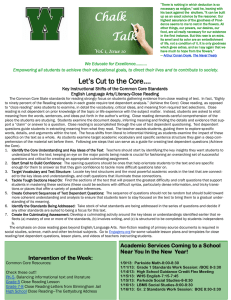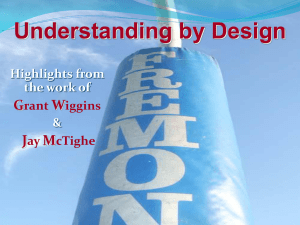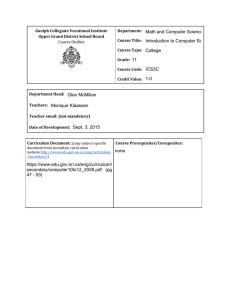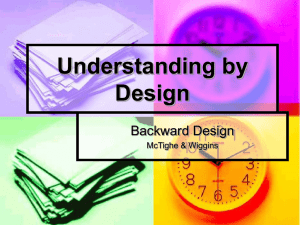Significant Concept
advertisement
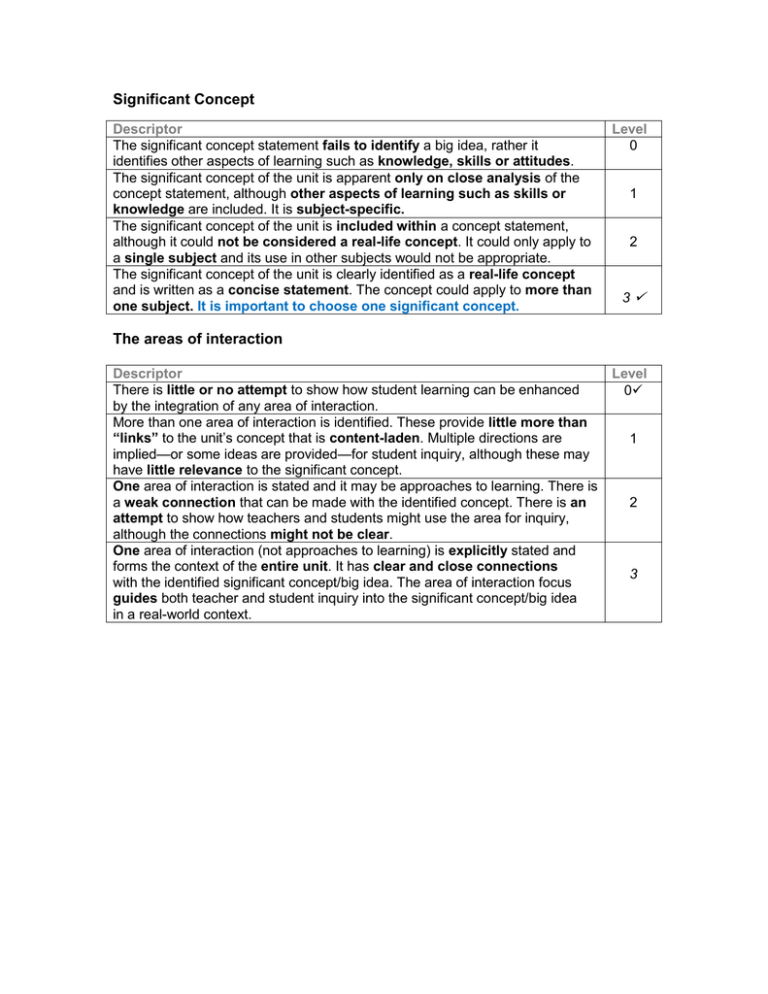
Significant Concept Descriptor The significant concept statement fails to identify a big idea, rather it identifies other aspects of learning such as knowledge, skills or attitudes. The significant concept of the unit is apparent only on close analysis of the concept statement, although other aspects of learning such as skills or knowledge are included. It is subject-specific. The significant concept of the unit is included within a concept statement, although it could not be considered a real-life concept. It could only apply to a single subject and its use in other subjects would not be appropriate. The significant concept of the unit is clearly identified as a real-life concept and is written as a concise statement. The concept could apply to more than one subject. It is important to choose one significant concept. Level 0 1 2 3 The areas of interaction Descriptor There is little or no attempt to show how student learning can be enhanced by the integration of any area of interaction. More than one area of interaction is identified. These provide little more than “links” to the unit’s concept that is content-laden. Multiple directions are implied—or some ideas are provided—for student inquiry, although these may have little relevance to the significant concept. One area of interaction is stated and it may be approaches to learning. There is a weak connection that can be made with the identified concept. There is an attempt to show how teachers and students might use the area for inquiry, although the connections might not be clear. One area of interaction (not approaches to learning) is explicitly stated and forms the context of the entire unit. It has clear and close connections with the identified significant concept/big idea. The area of interaction focus guides both teacher and student inquiry into the significant concept/big idea in a real-world context. Level 0 1 2 3 MYP Unit Question Open-ended Relevant and engaging The question: does not provide for student involvement fails to interest students. Challenging and provocative The question: does not seek to extend students’ capacities for new understandings. Significant is isolated from students’ prior knowledge and experience is phrased in adult language and adult thinking provides for little student interest. provides few opportunities for students to develop their understandings or skills. 1 is not content specific requires a response that is likely to be the same from student to student has boundaries set by the teacher. attempts to make connections to students’ prior learning is a “simplified” version of an “adult question” requires some student involvement. is not content specific is “open” such as ”how”, “why” is designed so that students can explore a variety of possibilities. assumes a degree of prior knowledge and experience “hooks” student interest in an age-appropriate manner is phrased in student-friendly language provides ways for students to be actively involved. seeks a limited extension of student knowledge and understanding provides some opportunities for students to increase their understandings and competencies. seeks to extend prior knowledge and understandings provides for varied ways in which students can increase their understandings and competencies could contain an unfamiliar big idea which requires “unpacking”. requires a response based on factual recall or the simple stating of an opinion that has little depth is teacher-centred or text-centred has little relevance to students’ lives. suggests or hints at a real-world context is connected to an aspect of adolescents’ lives, although it may not be ageappropriate is student-centred encourages students to consider the unit’s big idea and to reflect on it in the context of their adolescent world. 3 The question: is “closed”, requiring a yes/ no response (typical questions start with “can”, “does”,“should”, “do”, “will”). is content specific presumes that the answer could be known in advance, looked up or easily derived without serious thinking. The question: is irrelevant to students’ lives. Level 0 2 Summative assessment: culminating task Descriptor Level The culminating task is content-based and does not provide opportunities for students to demonstrate their understanding of the concept, skills and subject0 specific knowledge. The culminating task provides students with limited opportunities to demonstrate their understanding of the significant concept/big idea; the emphasis is on demonstrating developed skills and knowledge. The task 1 requires students to use a limited range of approaches to learning skills and subject knowledge that have few connections with the objectives that frame the unit. Students are directed to communicate their learning in one way. The culminating task allows students to demonstrate their understanding of the significant concept/big idea, although it may seem prescriptive and 2 restrict student options. The task requires students to use skills, some of which may be represented in the objectives framed by the unit, and selected subject-specific knowledge. There is some choice in the way that students communicate their learning, although these may not align with the objectives. The culminating task is open-ended and designed for students to demonstrate their understanding of the significant concept/big idea. The task allows students 3 to use their developed approaches to learning skills that are aligned with the MYP objectives identified in stage 2 of the planner, and their specific-subject knowledge. The task provides multiple ways for students to communicate their learning and aligns with the MYP objectives that frame the unit.
